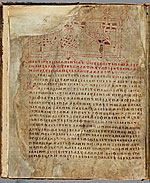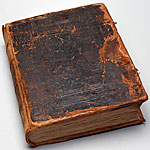Description of the Manuscript
What is the Laurentian Chronicle as a landmark in the history of the mediaeval hand-written book?
The Laurentian Chronicle is a codex written on parchment. Parchment, which is the skin of animals, processed so that it can be used to write upon its both sides, remained the main writing material in the 14th century Russia. In the case of the Laurentian Codex, the quality of the parchment is not fine. On many folios, it can be shown stitches (the cuts left during the making process and then sewn up) and holes of different sizes (caused by insect bites). The leaves of the manuscript carry the marks of ruled horizontal lines meant to help the scribe keep their writing straight. The book contains 173 parchment sheets, several leaves of manuscript have been lost (gaps are between nos.9 and 10, after f.169 and after f.170). The manuscript is made up from 24 gatherings of parchment sheets called quires. These quires commonly consist of 8 leaves. But at the end of the manuscript regular structure of quires is broken: a few leaves are cut off and replaced by others, pasted along the folded flanges (nos.157, 161, 167). This suggests that the text in the final part of the book was revised.
The text of the manuscript was written in two hands. The first 40 folios are made down in a uncial script that is the oldest style of writing adopted by Russia's scribes as early as the 16th century from Byzantium through the southern Slavs. The work of the first scribe, whose name we do not know, ended with the reverse side of leaf no.40, and the monk Laurentius wrote the remainder. He arranged the text in two columns and used a different type of writing - the

This script appeared in the second half of the 15th century. It is the evolution of the traditional uncial over nearly four centuries of its use in the Old Russian handwritten tradition. The Russian semi-uncial script existed not for long, because he was soon superseded by the South Slavic inclined half-uncial writing, which continued to evolve and be used for Russian manuscript documents until the early 20th century. Thus, the Laurentian Codex is an extremely valuable resource for paleographic studies, not only because the manuscript is dated, but also because its leaves trace the development of Russian calligraphy.
The book is adorned with a headpiece of the teratological style typical for the 14th century Old Russian manuscripts. The headpiece is placed in the very beginning, before the text, and features a double outline of strange birds, finely drawn in cinnabar red and included in an interlaced ornament. These birds of paradise seem to meet the reader as soon as they open the book. After all, when you open a book, you open a door to a completely different world, introducing you to enlightening knowledge and centuries-old wisdom of ancestors. Headlines, dates based on weather records, initial letter of articles, i.e. initials,- all this are executed in cinnabar. In the initial part of the manuscript, in which the text is written in uncial hand, the initials are decorated with an interlaced ornament. However, the first scribe did not have time to embellish all of cinnabar initials in his part. You can notice that a space, left on some leaves for ornamented initials, was afterwards filled up by undecorated letters like those that were used in Laurentius's cemi-uncial writing.Monk Laurentius's inscription at the end of the book is also done in cinnabar. Factual information about the creation of the manuscript, precious to us, was framed by Laurentius in traditional medieval literacy passages that expressed the spiritual joy of the scribe completing his work and his request to readers to forgive him, if they would find any slips in the text, 'because books are worn, and the mind is too young to understand'. Thus, we have learnt one more important detail - the Laurentian Codex was comiled from a time-worn ancient original.
Laurentian Codex has binding which is much later than the book and dates to the late15th - early 16th century from details of the binding structure. Binding served a protective function, preventing distortion of the parchment sheets. Therefore, covers are made of fairly thick wooden boards and are fitted with two thong-like straps, which have survived only in fragments, but once they securely held the book shut. The boards are covered with leather decorated with blind embossing. When the book was rebound, its text block edges were trimmed, especially upper side.Replacement of the original binding by the new one is a typical phenomenon. The more the book is read, the more damage it experiences on its spine. The Laurentian Codex was not only read, but it also was used as an original for creating other chronicles. This is evidenced by the numerous editorial notes in the margins - large or small crosses, as well as the word "Bulgar" that is found three times in the margins of different leaves. On some leaves, these notes were partially cut away. So, the Laurentian Codex was the source of further chronicles as early as the first century of its existence, seeing that editorial notes had been made before the text block trimming (when replacing the binding in the late 15th century or early 16th century).
At the late 18 - early 19 century, the block of the book was repaired - many damaged leaves were pasted up with parchment, some holes were patched, many seams were taped with strips of parchment, because the thread of which they were made, in most cases was murdered. Obviously, by that time Laurentian Codex had been in a fragile condition. And now its leaves display numerous signs of wax stains and lamp oil - the evidence of the reader's attention of many generations of our ancestors to this book. The first Russian historians, while studying Laurentian Codex, contributed to destroying the manuscript: some leaves carry traces of chemical reagents that were applied at the time in order to read faint writing, as well as to recover the original text where it appeared to have been changed.
The binding of the Laurentian Codex has been restored. The renewal was undertaken at the time when the book was already housed in the Imperial Public Library. The text block was re-stitched, the binding's fastening and spine were replaced (through this some decorative components of wooden boards were lost), fly-leaves of marbled paper and guarding paper sheets were added to the boards inside each cover.



